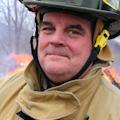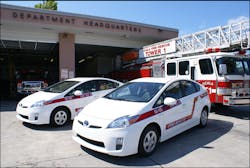Editor’s Note: In this article an expert makes a statement about the quality of the air that’s emitted from 2010 EPA compliant fire apparatus. He says people could stick their heads in diesel exhaust and not feel any ill effects, except a headache. No one is advocating that be done, and the statement was made to illustrate the point that technology has dramatically reduced environmentally harmful pollutants. There are other harmful contaminates in diesel emissions, including benzene, arsenic and formaldehyde, which are harmful to humans and potentially deadly over time. Normal ventilation and commonly practiced exhaust precautions are always recommended.
The sworn duty of virtually every firefighter on Earth is to protect life and property, so it makes sense that firefighters would want to protect the planet with green apparatus.
There's a bit of a disconnect, however, when it comes to the equipment needed for controlling emissions and the firefighting mission. Firefighters have the impression the technology impedes apparatus performance, but that's not exactly correct.
In 2010, the federal Environmental Protection Agency (EPA) is requiring near zero emissions from diesel-powered equipment, at least those on the road. Off-road applications are slightly more relaxed.
To meet the 2010 standards, engine manufacturers have developed complex systems that convert toxic pollutants into essentially harmless components - like water, nitrogen and carbon dioxide.
Many of the systems run seamlessly, in the background, using chemical reactions and heat to either burn off the pollutants or convert them into less harmful pollutants. On over-the-road vehicles, like tractor trailer trucks and commercial vehicles that run at highway speeds for long periods, the systems require little or no intervention from the operator.
Fire apparatus, however, are different animals than big rigs. Consequently, there is a little more operator involvement required.
"We don't fit the heavy-duty, over-the-road, Class A truck model, traveling 500 to 1,000 miles at a time," said Anthony Bulygo, a retired certified California mechanic and ASE Master Truck Technician.
Bulygo said longer travel times means hotter exhaust temperatures which means the emissions are burned off and converted more easily than on apparatus which spend a long time idling, or stationary pumping.
By way of explanation, today's on-road diesel engines require exhaust after treatment to meet the EPA standards. To do that, trucks typically have Diesel Particulate Filters (DPF) to remove the solids from black soot and Selective Catalytic Reduction systems to reduce the amount of mono-nitrogen oxides (NOx) in exhaust emissions to near zero. NOx is a byproduct of internal combustion engines and is a significant component of smog and air pollution causing lung tissue damage.
Bulygo said the technology is in its infancy, much like it was in the 1970s when the automotive manufacturers first installed emissions controls.
"Firefighters aren't happy," Bulygo said. "And the mechanics aren't happy with it either."
The after treatment systems cost between $8,000 and $10,000 per vehicle, according to Bulygo, who added it will pay firefighters to learn to live with the technology and how to maintain it because it's not going away anytime soon.
After treatment systems on today's apparatus are efficient he said, noting that the DPF and SCR treatments have reduced emissions, even since the 1970s, to one five hundredth of what they were.
"It's clean enough now that you can stick your head in the exhaust on a diesel and breathe it for a long time and you might get a headache," Bulygo said. "It certainly won't kill you."
Bulygo said that even though the systems are reasonably good at their missions, many fire departments have been resisting purchasing apparatus so equipped by pre-ordering apparatus before the 2010 standards were in place, or ordering apparatus with "new-old-stock" engines that were bought, but never installed, before the 2010 emissions regulations were effective.
Some departments are also deferring apparatus purchases for another five or six years, waiting to see what technology will usher in to replace the DPF and SCR systems. He's convinced that the current mechanics used to meet the standards are only a stop-gap measure until permanent solutions can be found.
Nevertheless, there are some fire departments that have the apparatus with the new technology on board and Bulygo said they ought to know how to operate it.
For instance, Bulygo recommends that firefighters not keep hitting a regeneration defeat switch that interrupts the high temperature run of the DPF which will, in the long run, clog up the device requiring expensive replacement. The defeat switch is largely for emergencies, such as when the truck is parked in a place where the high temperatures in the exhaust might cause damage or be dangerous, not just an inconvenience.
The SCR system also requires some attention too. Most diesel trucks need Diesel Emissions Fluid (DEF) to run properly. DEF is a non-toxic liquid that's 32.5 percent urea in water that's dosed into the SCR at the rate of about 1.5 gallons for 50 gallons of diesel fuel. On-board tanks typically hold between 5 and 10 gallons of the solution.
DEF is sent into the SCR as a mist, breaking down into ammonia and creating a chemical reaction to oxidize with the NOx, breaking it down into nitrogen and water, two common and harmless components of the atmosphere in nature.
Bulygo, who is also a retired certified ASE Master Truck Technician with membership in many professional associations and numerous certifications, said firefighters will also need to keep up with the manufacturers' software updates for the engine's controls.
"All of the manufacturers have done a good job making this as workable as it can be," said Bulygo, who has more than 40 years experience in apparatus repair and maintenance.
"Did the air need to be cleaned up, sure," he said. "Does it require the kind of equipment we're mandated to have to do so? That's debatable."
While after-treatment of diesel exhaust has captured the attention of the fire service, there are other ways to clean up the air, or at least try to reduce the pollution produced.
While the bugs are being worked out, some manufacturers and departments are getting very creative about other ways to be compliant with the new standards and keep the environment green.
The Ocala, Fla., Fire Department added two 2010 Toyota Prius hybrid vehicles to its fleet this summer in an effort to save fuel and to make the department more environmentally efficient. The vehicles have been assigned to administrative staff.
According to the department, the hybrids are rated at 51 miles per gallon with the capability of automatically switching from gasoline to battery power.
"We are excited to put these vehicles into service, and it sends the right message to the community during these economic times," said Fire Chief Dan Gentry.
This year, apparatus builder Rosenbauer America, headquartered in Lyons, S.D., offered its green technology with apparatus equipped with Green Star technology.
Like one of the features on E-ONE's hybrid command vehicle, it's designed to reduce emissions by shutting off the main engine and providing alternative power to run the apparatus and any accessories and equipment that might be deployed at a scene.
The auxiliary power unit is a small generator that is able to power all of the apparatus accessories, including air conditioning and heating while automatically shutting down the apparatus' main power plant engine. By shutting off the main engine when it's not needed, emissions are reduced and fuel is conserved, according to Rosenbauer.
The maker's research shows that apparatus idle between 10 to 40 minutes on the scene of an average call while the big-block engines are consuming fuel at the rate of one gallon per hour and belching the equivalent in emissions. Green Star equipped apparatus burn fuel at the rate of one quart per hour, representing a savings of up to 75 percent, the company said. And, by shutting off the main engine, the costly emissions filters and regeneration systems in the exhaust system are preserved for times when the main engine must be running during pumping and on the road.
One manufacturer has gone in a completely different direction when it comes to green technology and has employed a previously untapped fuel for powering apparatus - compressed natural gas (CNG).
Earlier this year, HME Ahrens-Fox introduced a pumper with a Cummins Westport CNG-powered 8.9-liter engine producing 320 horsepower and 1,000-foot torque. That's plenty to power up to a 1,500-gpm fire pump.
The CNG-fired pumper meets, or exceeds the EPA 2010 emission requirements as well as the California Air Resources Board (CARB) 2010 standards without the need for Diesel Exhaust Fluid (DEF) or Selective Catalytic Reduction (SCR) system that diesel engines require, according to Dave Fornell, HME Ahrens Fox's director of marketing.
Fornell said the apparatus is not only clean; it's also quiet with lots of acceleration.
As the nation's apparatus fleet continues to be retired from service, more and more apparatus with DEF and regeneration systems will be integrated into departments' frontlines.
Engine and apparatus manufacturers have gone to great lengths to make those systems reliable and user friendly. In most apparatus and diesel-power trucks, the adding of DEF is no more complicated than adding washer fluid. Simply pouring the non-toxic, colorless, odorless fluid into an on-board tank is typically all that's required from firefighters and operated. Depending on the size of the fuel tank and the size of the DEF tank, its typically refilled at no more than once per tank full, sometimes much less.
The only other thing that firefighters need to worry about is high exhaust temperatures when the apparatus goes into a regeneration mode - a process where the filters and exhaust system operates at a much higher temperature to burn off the emissions trapped in the system and convert them into water, carbon dioxide and nitrogen which are less harmful the environment than NOx which is a prime ingredient in smog.
Like many things in the fire service, the DEF and SCR will take time to be accepted by the firefighters and those who maintain apparatus. The time is now, however, for that embrace to happen because the deadline for compliance is here and departments will no longer be able to purchase new apparatus that is non-compliant.
"I don't believe there will be any huge problems as long as the firefighters get the training they need on how to use it and the individual (departments) get the updates on the software as needed," Bulygo said. "…The atmosphere needs to be cleaned up. That's where we're going and there's going to be more design changes to meet the standard. For now, we'll have to make do with what we've got."
About the Author

Ed Ballam
Ed Ballam served as associate editor for Firehouse. He is the assistant chief of the Haverhill Corner, N.H. Fire Department, and a National Registered EMT. He is also a Deputy Forest Fire Warden for the New Hampshire Division of Forests and Lands. Professionally, he's been a journalist for over 35 years working for a variety of publications, including employment as managing editor of a national fire service trade journal for more than a decade.
